First: Download and install SeaTools.
Launch SeaTools by following these steps once it is installed:
If you have a SeaTools for Windows icon on your desktop, simply launch the program from here. If not, follow these steps.
- Click on Start.
- Select Programs.
- Select Seagate.
- Select SeaTools for Windows.
A. Prepare the System
- Isolate SeaTools - close all other applications before running a hard disk diagnostic. The main reason for this is to keep the drive focused on SeaTools as much as possible. Otherwise, Windows will continue to give the disk drive commands to access data for the needs of the other applications. When that happens, SeaTools will temporarily suspend its current progress while the drive is busy. This is harmless to the drive and a routine condition of use; however, it causes the SeaTools tests to take much longer time to complete. This is harmless to the drive and a routine condition of use; however, it causes the SeaTools tests to take much longer time to complete.
- SeaTools' Drive Identification - External drives that connect to the system through USB, 1394 Firewire, or eSATA do not have the same background activity as the internal drive. Internal drives are identified as PATA (Parallel ATA or IDE), SATA (Serial ATA), SCSI, or SAS (Serial-Attached SCSI). Most desktop and notebook systems have one SATA or PATA internal drive.
- Keep the computer fully powered on - Power management controls may need to be suspended while doing very long tests. A complete drive scan may take a few hours to complete. The drive is working on its own at these times and the system may decide it should go into Standby or Hibernate modes.
- Click on the Start or Windows icon button in the bottom left corner of your Windows desktop.
- Select Control Panel.
- Select Power Options.
- The setting "Turn off hard disks" should be set to "Never" while running any SeaTools for Windows test.
- Plug in your laptop computer - Laptop systems should not run the long tests using just battery power. These tests are disk-intensive and will draw more current than a typical usage profile. Be sure to connect the AC adapter to ensure adequate power during the tests.
B. Select the Drives to Test
After SeaTools loads, the screen will list the different storage devices in your system. Select the drive you would like to test by making a check mark in the box next to the drive information. This screen also displays information about the drives such as the Model Number and Serial Number. Seagate model numbers begin with the letters "ST". Seagate serial numbers are alphanumeric and eight characters long.
However, Seatools for Windows often displays the serial number and even the model number of the internal drive inside the external case, and these numbers do not correspond to the numbers that Seagate assigns to the external unit as a whole.
(For help on finding the model number of a drive, please see our "Find Your Model and Serial Numbers" Knowledge Base article.)
Seagate, Samsung, LaCie and Maxtor drives models are given a gold drive icon. Non-Seagate drives have a silver drive icon
You may select more than one drive at a time to test them simultaneously.
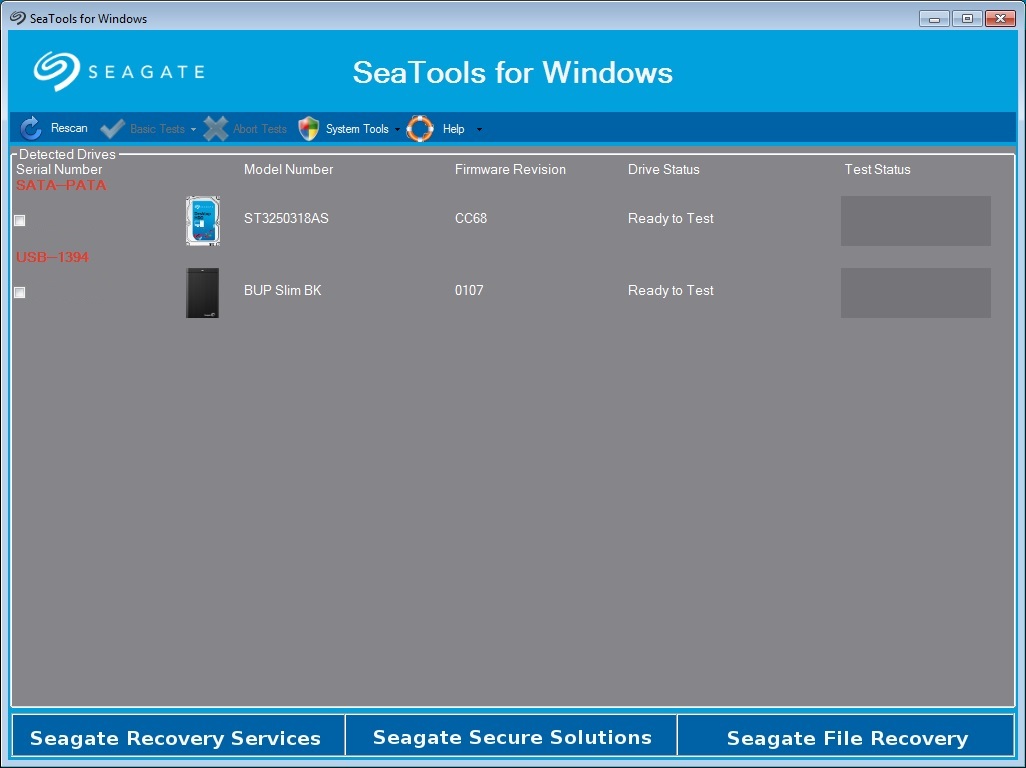
C. Select the Tests to Run
A menu of the possible diagnostic tests is shown. All Basic Tests are data safe, read-only tests. Select the tests that you would like to perform. The test will begin immediately.
These tests include:
- Fix All
- Short Drive Self Test (20 to 90 seconds long)
- Drive Information
- Short Generic
- Long Generic (progress in 1% increments and may take several hours to complete)
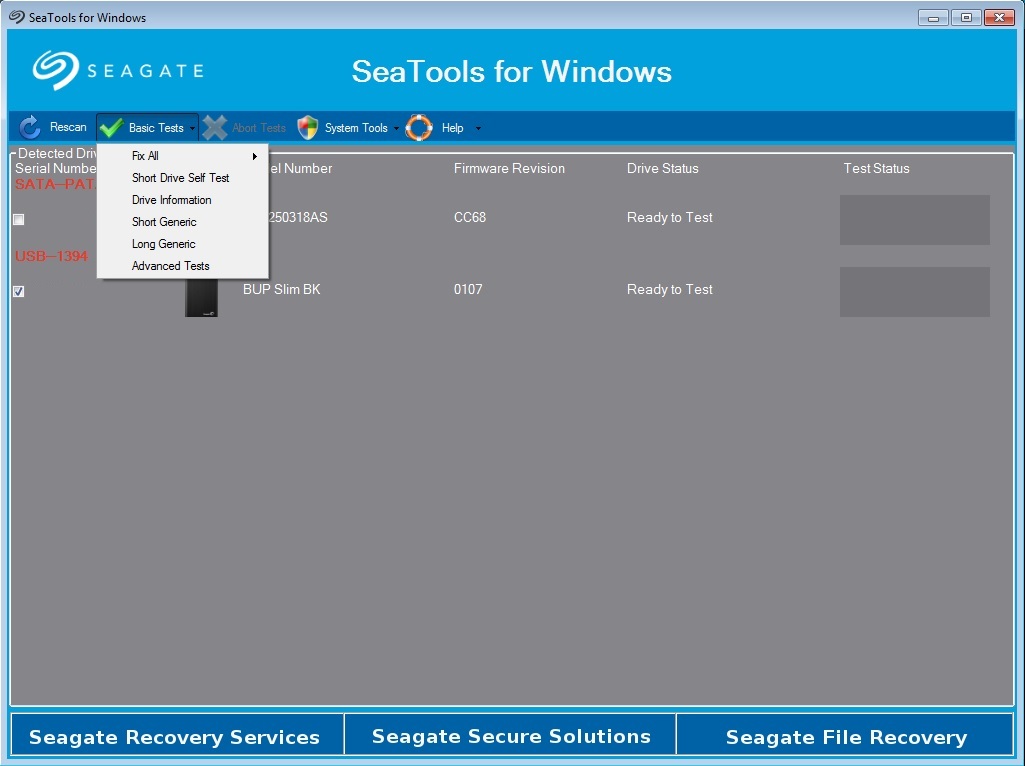
When you launch the "Short Drive Self Test" (DST) most drives will run a thorough diagnostic routine that is built into the hard drive's firmware. DST is completely data safe.
The "Short Drive Self Test" is adequate for most situations. The “Short Generic” test is similar and tests various areas of the drive. If you need a more comprehensive test then consider running the “Long Generic”, which reads each sector on the drive.
The long tests will take time to complete. Because the long tests read every sector on the drive, the amount of time required will depend on the speed and capacity of the disk drive. The apparent lack of activity often gives the impression that the drive or software has stopped responding.
The “Fix All” tests provide the ability to fix problem LBA’s (bad sectors). There are two options with the “Fix All” tests, “Fast” and “Long”. Be sure that you have all of your data backed up before running any of the “Fix All” tests. When SeaTools reallocates these problem sectors the actual data in a particular sector is unreadable and already lost. Unless the drive is full of data, it is quite possible for the problem sector to be empty of data, anyway.
“Fix All Fast” uses the drive's activity logs to identify suspicious sectors which may or may not be bad. SeaTools goes to each one in the list and if it really is bad the program will try to reallocate that one sector. If successful SeaTools moves on to the next if not successful then the test fails. On average the time is less than 5 minutes.
“Fix All Long” does a sequential scan of the media and discovers any problem sectors and attempts to reallocate them along the way. The time is very long and may take several hours (about 3 hrs per TB).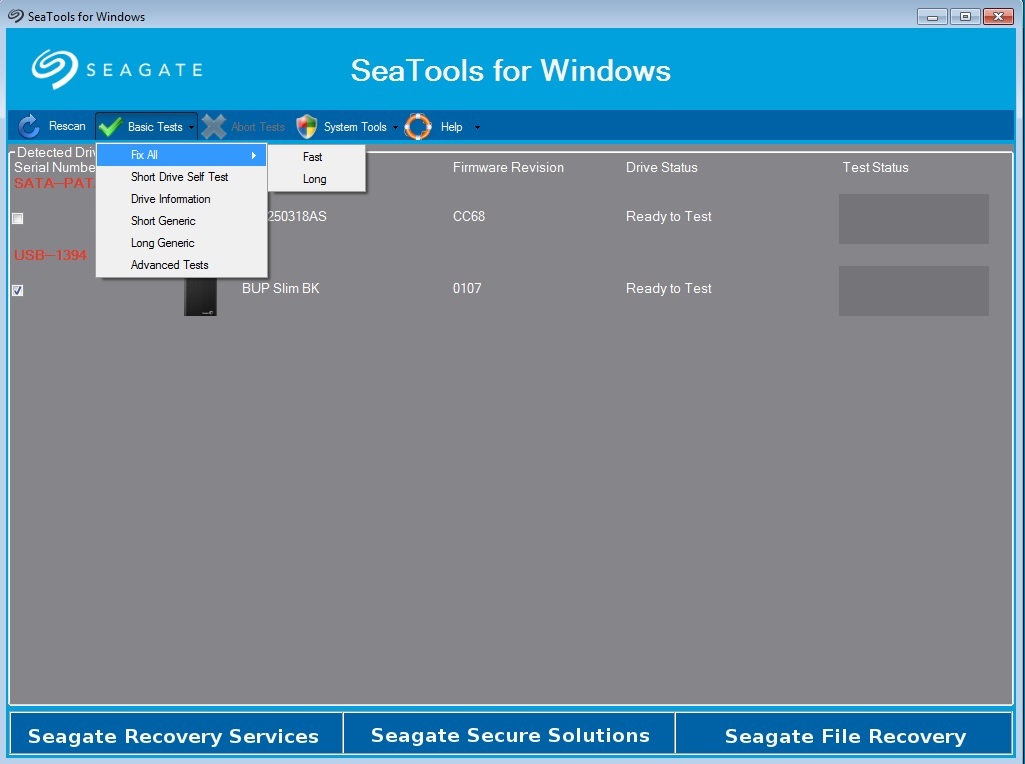
D. Aborting the Diagnostics
The SeaTools performs a data-safe test of the selected hard disk drive or device for possible malfunctions. Long tests may be aborted at any time. Select the Abort Tests icon from the menu bar. You can abort the test at any time without harming the drive, although the drive will not be fully tested if the test is aborted.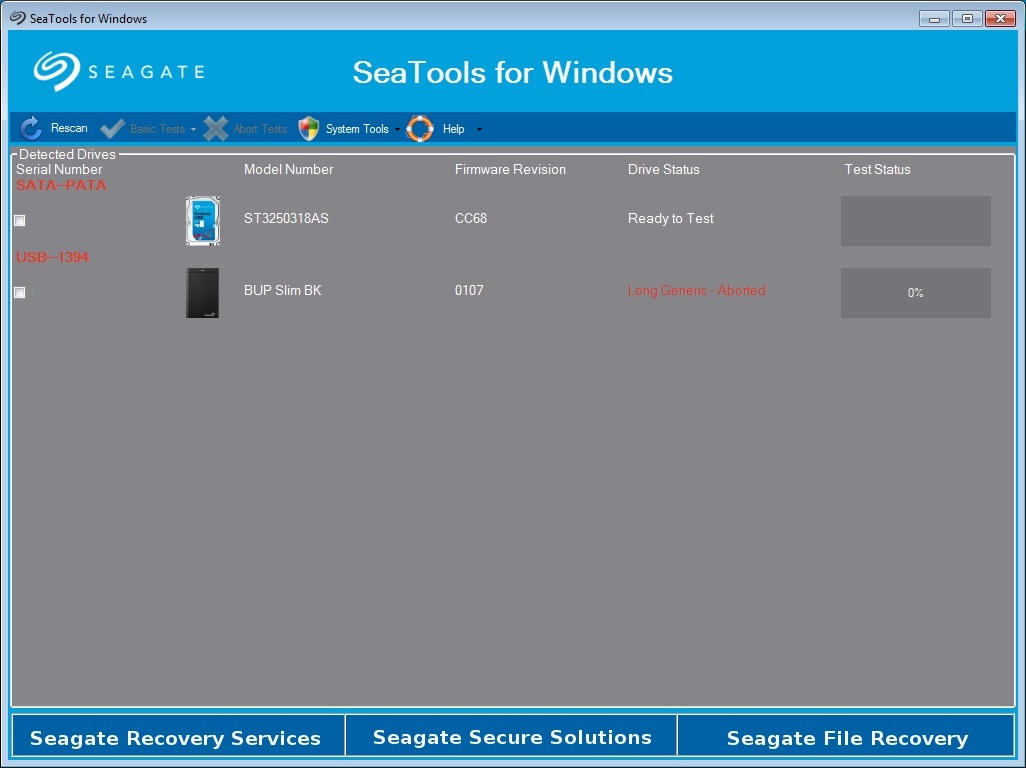
E. Summary of Results
Upon completion of running the diagnostics, a log for each drive is saved to the program installation folder. You can read the log by clicking on Help> View Log File. You can also view a log about the test results by clicking on either “Pass Info” or “Fail Info”, depending on the results of the test, when the test is done next to the “Help” option. Then you will see three tabs: “Pass Info”, “Warranty Checker” and “View Log File”.
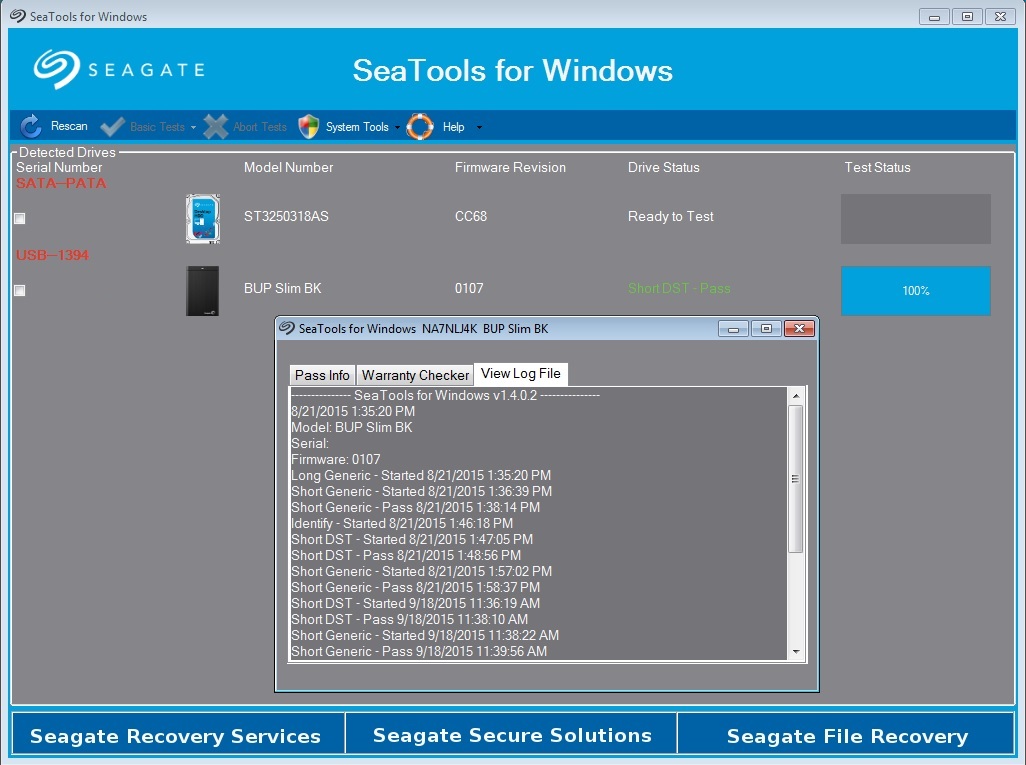
The following conditions may apply to the test results:
- Passed
- Failed
- Aborted
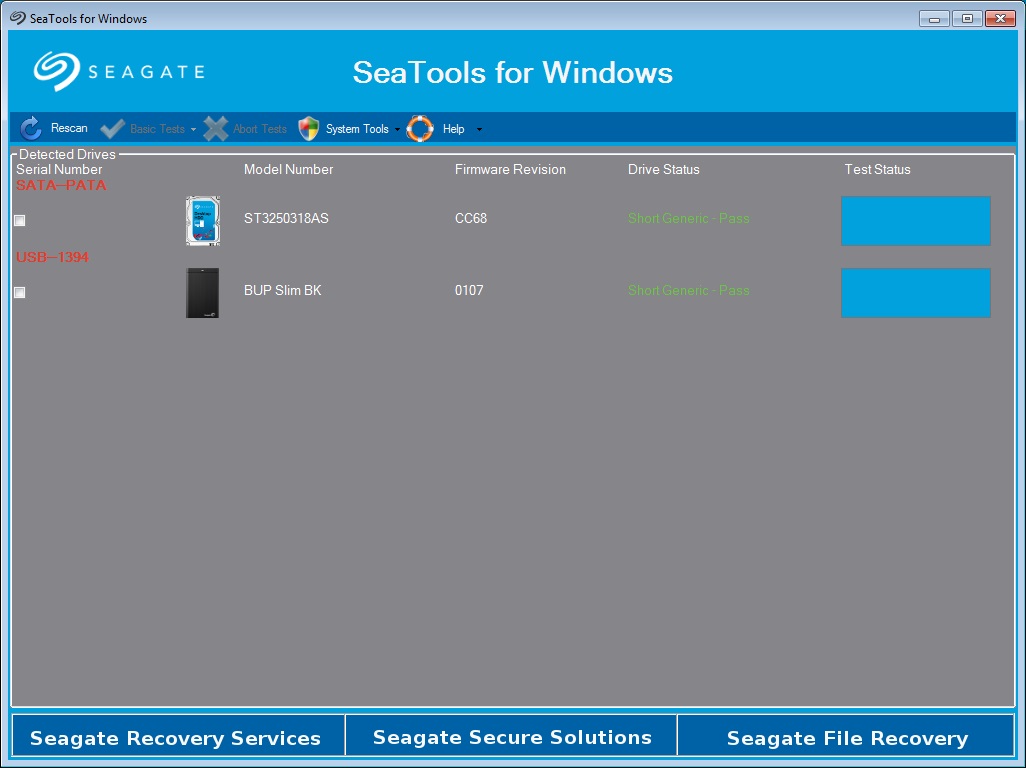
More often than not, SeaTools for Windows will test with a PASS status. SeaTools for Windows is a useful testing tool to eliminate the hard disk drive as the source or physical cause of some system problem.
A drive can be perfectly healthy but also have corrupted data. If this is the case, perform a chkdsk operation. If it fails, then the data needs to be re-installed, re-saved or recovered.
Bad sectors (LBAs) may be detected during the test. The test will halt with a Fail status. SeaTools for Windows has the ability to repair bad sectors using the “Fix All” option under the “Basic Tests” button. Chkdsk can also repair bad sectors.
If this software indicates a FAIL test status and you are testing an external hard drive, which uses a USB or 1394 type of bus connection then you should consider using the “Fix All Long” option. Make sure that, if you can access your data, you have everything backed up before running the “Fix All” option. Seagate Recovery Services will not be able to recover data from an unreadable sector. If you do not have all of your data backed up and you cannot afford to lose any of the data then you should contact our data recovery department, Seagate Recovery Services. To run a “Fix All” option put a check mark inside the box next to the serial number you wish to run it on. Then click on “Basic Tests”, then hover your mouse over “Fix All” and click on “Long”. Next you’ll see a window pop up telling you to backup your data and explaining the test. From here you will need to press F8 to begin the “Fix All” selection.
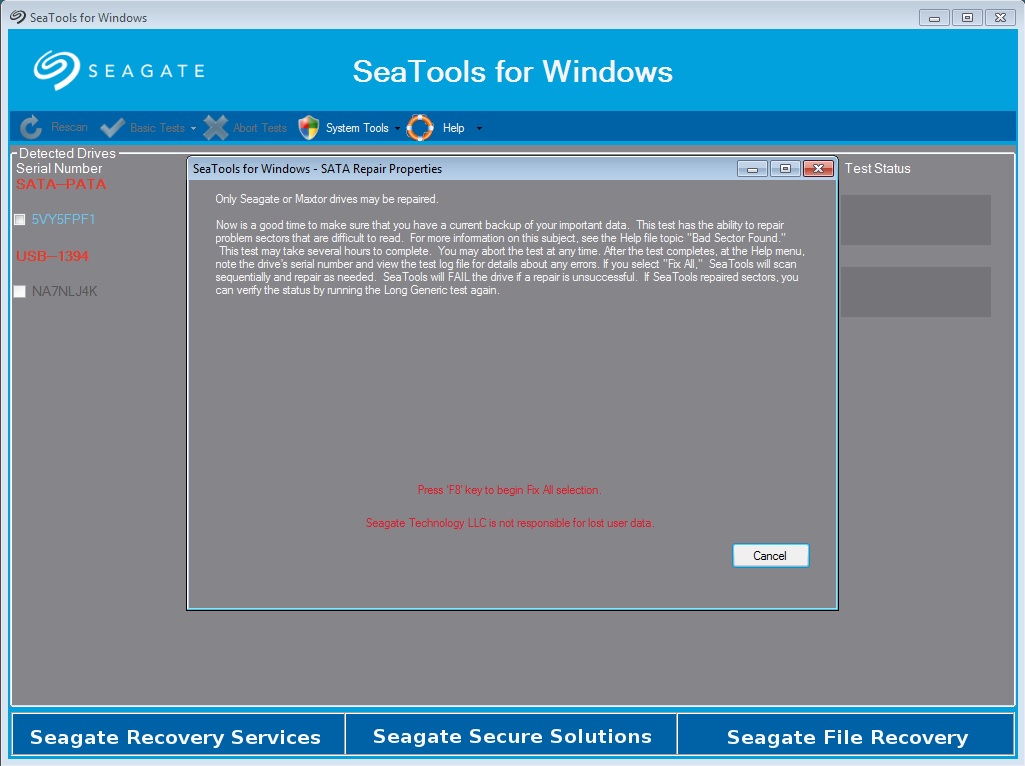
SeaTools will FAIL the drive if a repair is unsuccessful. If SeaTools fails to repair the bad sectors we recommend checking the warranty status of your device.
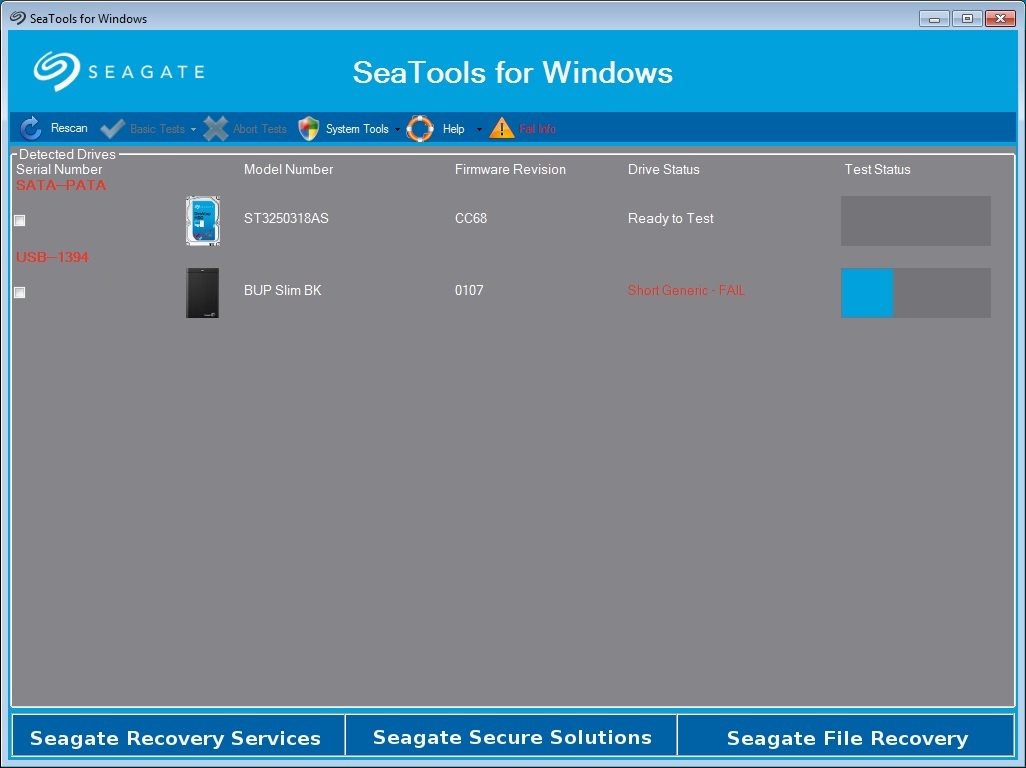
If you are testing an internal PATA (IDE) or SATA disk drive we recommend that you run the “Long Test” in the bootable version, SeaTools for DOS, which has the ability to repair bad sectors also. Running the “Fix All” tests on an internal drive that is also running your operating system will make the test take a longer amount of time. Using the bootable DOS version of SeaTools will allow the tests to run much faster. To do this you will need to burn the ISO file to a CD, then boot to the disk and run the “Long Test” from there. The SeaTools for DOS ISO file can be found in the SeaTools for Windows program files installation folder. When you run the “Long Test” SeaTools will give you a list of the problem LBA’s (bad sectors) at the end of the test and ask you if you want to repair them all or one at a time. If the test fails to repair the bad sectors, we recommend checking the warranty status of your drive.
You can check the warranty status for Seagate products at the Seagate Warranty Validation page. You will need to write down the serial number for the drive you intend to check. Please click here to continue to the Warranty Validation Page.
Please remember that SeaTools for Windows sometimes displays the serial number and even the model number of the internal drive inside the external case. This only occurs with external drives. See the drive label to verify that the serial number is correct.










